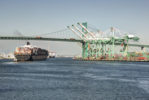
Visit Our Sponsors |
|
|
|
|
|
|
|
|
|
|
|
|
|
|
|
|
|
|
|
|
|
|
|
|
|
|
|
|
|
|
|
|
|
|
|
|
|
|

A fast food worker prepares a burrito. Photo: Kzenon/ Canva.
Chipotle Mexican Grill Inc. is understandably zeroed in on food safety. Four years ago, the company agreed to pay a record $25 million fine to resolve criminal charges arising from foodborne illness outbreaks at its restaurants between 2015 and 2018. Now, though, it’s taking food security and supply chain visibility to a new level, by offering customers information about the source of every ingredient on its menu.
Chipotle has implemented a technology platform that allows it to share data across the network, all the way back to the individual farm, according to Carlos Londono, vice president and head of supply chain. He spoke at the National Retail Federation’s Supply Chain 360 conference in Cleveland, Ohio.
Londono said the traceability technology gives customers information about the carbon footprint of each supplier. “You’re able to see exactly what your burrito did for the environment.”
The hope is that the data will influence customer buying behavior, further contributing to the company’s efforts to boost supply chain sustainability. “Knowing where the food comes from makes an enormous difference,” Londono said. Supporting the raw data is a team of auditors who regularly visit farms and factories to ensure that suppliers are remaining compliant with strict food-safety measures.
Londono believes it’s especially important for Chipotle to maintain close ties to suppliers. He told of visiting a factory in China five years ago, shortly after joining the company, only to learn that he was the first representative of Chipotle to have appeared there in person in 25 years.
Like all restaurant businesses, Chipotle’s supply chain has felt the impact of COVID-19. In the end, though, it was less affected than many due to a matter of fortuitous timing. Four years before the pandemic hit, the company began putting into place contingency plans to cope with supply chain disruptions. The initiative was meant to support ambitions to expand from around 3,000 restaurants to 8,000 within the next five to seven years. But it turned out to yield value in the much shorter term.
“Chipotle during COVID had no shortages,” said Londono. “We never ran out of anything.”
Other were caught short by an overly “lean” approach to inventory, motivated by an obsession with cost control, to the point where “a tiny change means you’re out of stock.”
Today, Chipotle faces the new challenge of coping with record inflation, not to mention continuing factory shutdowns caused by the lingering pandemic, and congestion at key U.S. ports. In response, the company is looking to diversify at least a portion of its supply base. “Our food is 100% fresh,” said Londono. “I don’t have the ability to respond if something happens in a single-sourcing network.”
Even with that strategy in place, the company’s supply chain is far from perfect. “It blows my mind that in an age of super information, demand and supply still don’t meet,” Londono said. “So we’re trying to address the asymmetry of information, to make sure that people are coming together.”
RELATED CONTENT
RELATED VIDEOS
Timely, incisive articles delivered directly to your inbox.






